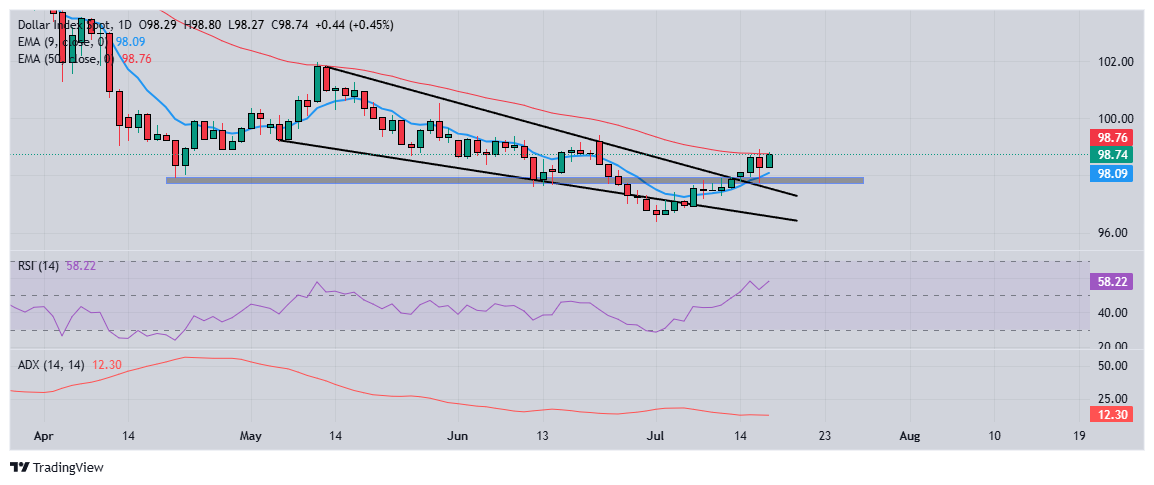- The US dollar remains firm while US president Donald Trump goes back in the threat of dismissing the president of the Fed, Jerome Powell.
- The American dollar index is listed by three weeks, driven by persistent inflation and stable yields of treasure bonds.
- The technical rupture indicates a bullish impulse, with upward objectives in 99.50 and the psychological level of 100.00.
The US dollar (USD) earns positive traction on Thursday, recovering from a brief wobble late Wednesday after reports that US President Donald Trump was considering saying goodbye to the president of the Federal Reserve (Fed), Jerome Powell. The market tensions relaxed after Trump went back to the threat, stating that it was “highly unlikely” to dismiss Powell. The stable yields of the treasure bonds, the signals of persistent inflation and the hard line expectations around the path of the Fed monetary policy maintain the demand of the dollar in the main currency pairs.
The US dollar index (DXY), which tracks the value of the dollar against a basket of six main currencies, is quoting in the front near maximum three weeks during the European negotiation session. At the time of writing, the index is around 98.74, rising 0.45% in the day.
Political interference in the Federal Reserve can create serious problems for financial markets. If Powell were dismissed, he could shake the confidence in the independence of Fed. A new president could adopt a different approach to interest rates, possibly cutting them faster. This can affect trust in the US dollar and lead to greater volatility in shares and bonds. Several senior Wall Street executives have warned that if the independence of the Fed weakens, it could harm the US economy in the long term and erode the status of the dollar as the world reserve currency.
Although recent consumer price index (CPI) data and production price index (IPP) have shown cooling signs, with June consumer prices by increasing at a slower pace and producers’ prices keeping stable month by month, the broader price trend remains persistent. In addition, several Fed officials maintained a cautious tone on Wednesday, citing the risks of increasing inflation linked to recent commercial tariffs. This gives the Fed reasons to postpone rates cuts for now.
The operators now focus their attention on the next US economic data scheduled for publication on Thursday, including retail sales, initial weekly applications for unemployment subsidy and the manufacturing survey of the Fed of Philadelphia, in search of new tracks on the next Fed movement.
The US dollar also finds support in the high yields of treasure bonds and persistent global uncertainty, including renewed commercial tensions and threats of President Trump, which could further feed inflation and complicate the Fed policy perspective.
Market movements: tariff tensions increase, inflation jumps and rates cuts are discarded
- The general IPP remained flat in June, without monthly growth, compared to the increase of 0.2% expected by markets, and lowering an increase of 0.3% in May. The surprise in softness was due to lower service costs, despite a slight increase in goods prices. In annual terms, the IPP slowed to 2.3%, also below the 2.5% prognosis and reading 2.6% of the previous month. The data suggests that inflation at the level of producers is maintained under control, relieveing some concerns about tariff price pressures. However, the persistent underlying inflation maintains the policy perspective of the Fed inclined towards a hard line posture, limiting the falls of the US dollar.
- Consumer inflation in the US accelerated in June, with the general CPI rising a monthly 0.3% and 2.7% year -on -year, both in line with expectations. The underlying IPC, which excludes food and energy prices, rose 0.2% monthly and 2.9% year -on -year. The data showed clear price signals related to tariffs. The highest inflation figure has drastically reduced the probabilities of a short -term Fed fees. Markets now value only a 2.6% probability of relief in July and 55.8% for September, lowering 70% of last week.
- On Wednesday, the president of the Fed in New York, John Williams, warned that the total economic impact of tariff to 5%, which suggests that underlying inflation could be increasing.
- President Trump pointed out a tougher position on trade on Wednesday, confirming that the 25% tariff on Japanese imports will remain. When asked about a possible agreement, Trump replied: “I think we will probably live according to the letter,” implying that there is no probable agreement in the short term. Trump also announced plans to send letters to more than 150 smaller countries, warning that their tariff rates could increase to 10% or 15%. He indicated that these countries “do not do much business” with the US and that the new rates would be “for everyone, for that group.”
- With the deadline of tariffs on August 1 approaching, only the United Kingdom, Vietnam and Indonesia have secured formal commercial agreements with the United States, while China has reached only a “preliminary commercial agreement.” The US is allegedly “very close” to end an agreement with India and sees potential for an agreement with the European Union (EU), although both remain in negotiation.
- The US Census Office is ready to publish June retail sales data on Thursday at 12:30 GMT, with economists waiting for a bounce of 0.1% monthly, after a strong fall of -0.9% in May. Basic retail sales are expected to exclude cars and gasoline, increase 0.3%, recovering from a 0.3% drop the previous month.
Technical analysis: DXY bulls regain control after the breakdown of the descending wedge pattern

The American dollar index (DXY) shows early signs of a bullish reversal after breaking a descending wedge pattern that had limited the price action for more than two months. This rupture suggests that the bearish momentum is weakening and that buyers are gradually recovering the control. The index is now testing a key resistance zone around 98.70-98.80, which is aligned with the 50-day exponential (EMA) mobile average. A clear break and a daily closure above this area could confirm the bullish impulse and pave the road to the 99.50 region, near the maximum swing of June 23, and possibly extend to the psychological level of 100.00.
Down, the 9 -day EMA in 98.09 continues to act as a short -term dynamic support, leaning up and helping to cushion minor setbacks. It also aligns with the old resistance zone converted into support about 98.00-97.80. A rupture below this area could undermine the bullish impulse and expose the index to a deeper setback, with the following support seen about 97.50.
Momentum indicators support the bullish inclination. The Relative Force Index (RSI) is increasing and is located about 58 in the daily chart, indicating a growing purchase interest without even reaching overcompra conditions. However, the average directional index (ADX) remains low in 12.30, which implies that the trend is still being developed.
Economic indicator
Retail sales (MOM)
This survey of goods sold by retail merchants publishing the Census Bureau It is based on a sample of retail stores of different types and is considered an indicator of the economy growth rate. It shows the performance of the retail sector in the short and medium term. A result superior to the market consensus is bullish for the dollar, while a lower result is bassist.
Read more.
Next publication:
Jul 17, 2025 12:30
Frequency:
Monthly
Dear:
0.1%
Previous:
-0.9%
Fountain:
US Census Bureau
Retail Sales Data Published by The US Census Bureau is a leading indicator that Gives Importion Information about consumer spending, which has a significant impact on the GDP. Although Strong Sales Figures Are Likely to Boost The USD, External Factors, Such As Weather Conditions, Could Distort The Data and Paint A Misleading Picture. IN ADDITION TO THE HEADLINE DATA, CHANGES IN THE RETAIL SALES CONTROL GROUP COULD TRIGGER A MARKET REACTION AS IT IS USED TO PREPARE THE ESTIMATES OF PERSONAL CONSUMPTION EXPECTURES FOR MOST GOODS.
Source: Fx Street
I am Joshua Winder, a senior-level journalist and editor at World Stock Market. I specialize in covering news related to the stock market and economic trends. With more than 8 years of experience in this field, I have become an expert in financial reporting.







